2009 INFINITI QX56 lock
[x] Cancel search: lockPage 3788 of 4171
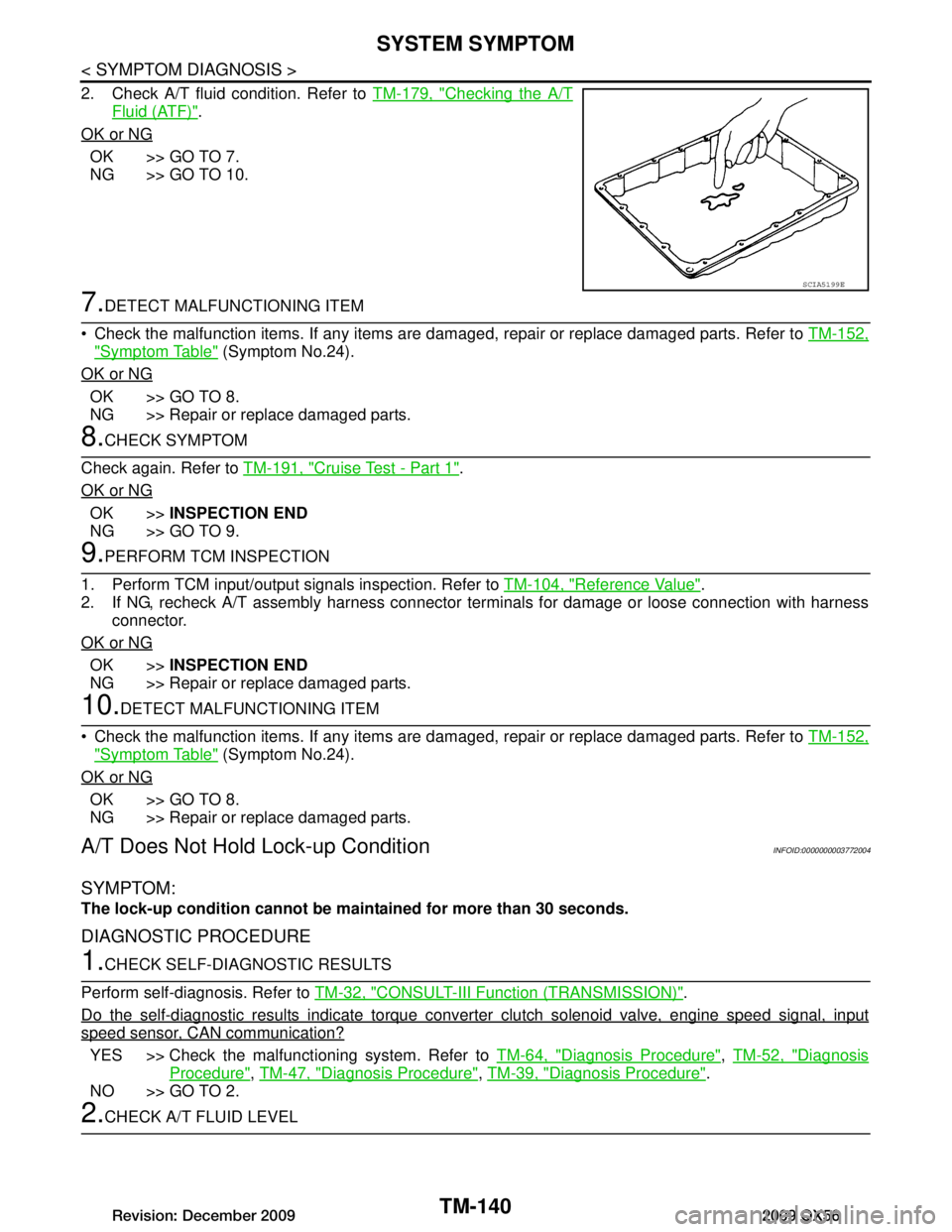
TM-140
< SYMPTOM DIAGNOSIS >
SYSTEM SYMPTOM
2. Check A/T fluid condition. Refer to TM-179, "Checking the A/T
Fluid (ATF)".
OK or NG
OK >> GO TO 7.
NG >> GO TO 10.
7.DETECT MALFUNCTIONING ITEM
Check the malfunction items. If any items are dam aged, repair or replace damaged parts. Refer to TM-152,
"Symptom Table" (Symptom No.24).
OK or NG
OK >> GO TO 8.
NG >> Repair or replace damaged parts.
8.CHECK SYMPTOM
Check again. Refer to TM-191, "Cruise Test - Part 1"
.
OK or NG
OK >> INSPECTION END
NG >> GO TO 9.
9.PERFORM TCM INSPECTION
1. Perform TCM input/output signals inspection. Refer to TM-104, "Reference Value"
.
2. If NG, recheck A/T assembly harness connector terminals for damage or loose connection with harness
connector.
OK or NG
OK >> INSPECTION END
NG >> Repair or replace damaged parts.
10.DETECT MALFUNCTIONING ITEM
Check the malfunction items. If any items are dam aged, repair or replace damaged parts. Refer to TM-152,
"Symptom Table" (Symptom No.24).
OK or NG
OK >> GO TO 8.
NG >> Repair or replace damaged parts.
A/T Does Not Hold Lock-up ConditionINFOID:0000000003772004
SYMPTOM:
The lock-up condition cannot be ma intained for more than 30 seconds.
DIAGNOSTIC PROCEDURE
1.CHECK SELF-DIAGNOSTIC RESULTS
Perform self-diagnosis. Refer to TM-32, "CONSULT-III Function (TRANSMISSION)"
.
Do the self-diagnostic results indicate torque conv erter clutch solenoid valve, engine speed signal, input
speed sensor, CAN communication?
YES >> Check the malfunctioning system. Refer to TM-64, "Diagnosis Procedure", TM-52, "Diagnosis
Procedure", TM-47, "Diagnosis Procedure", TM-39, "Diagnosis Procedure".
NO >> GO TO 2.
2.CHECK A/T FLUID LEVEL
SCIA5199E
Revision: December 20092009 QX56
Page 3789 of 4171
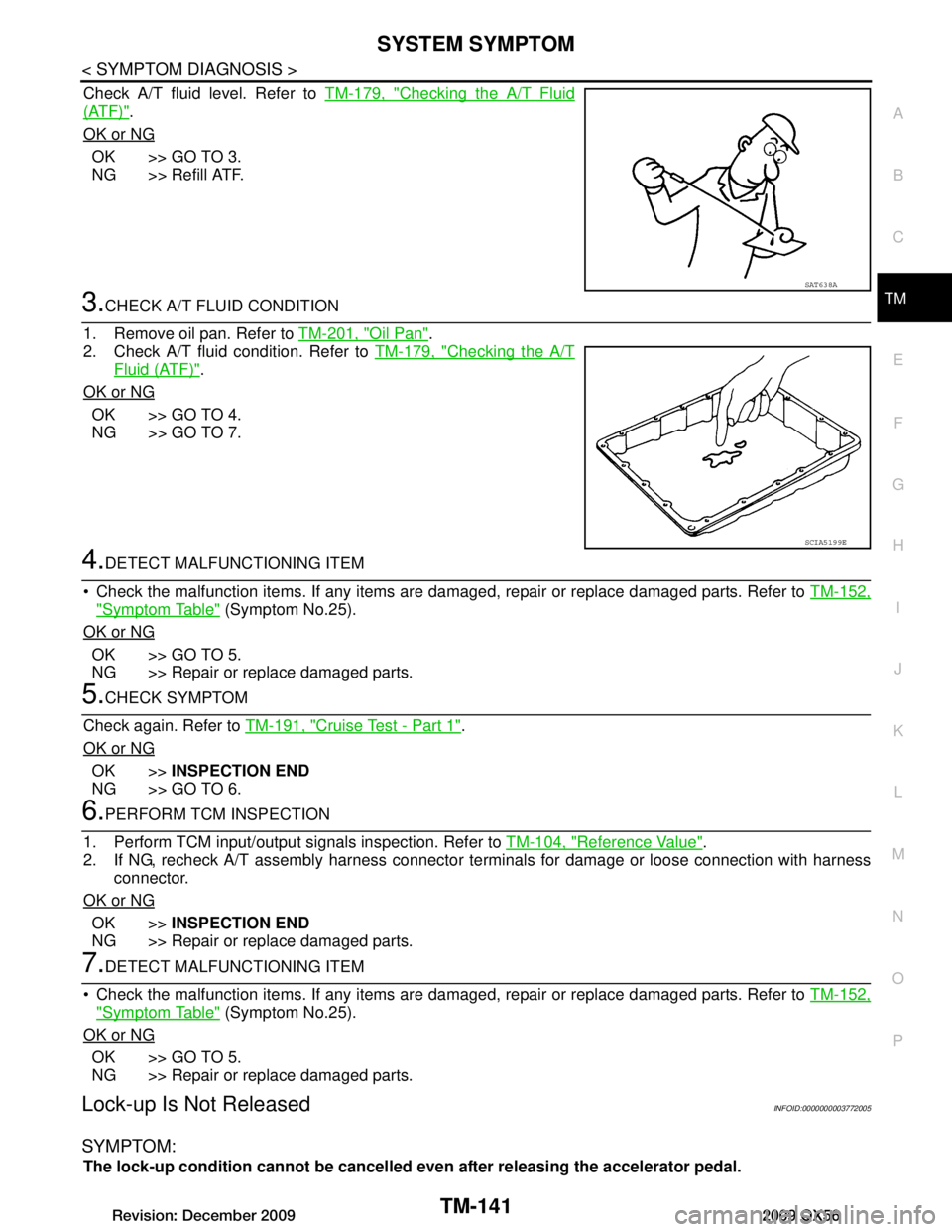
SYSTEM SYMPTOMTM-141
< SYMPTOM DIAGNOSIS >
CEF
G H
I
J
K L
M A
B
TM
N
O P
Check A/T fluid level. Refer to TM-179, "Checking the A/T Fluid
(ATF)".
OK or NG
OK >> GO TO 3.
NG >> Refill ATF.
3.CHECK A/T FLUID CONDITION
1. Remove oil pan. Refer to TM-201, "Oil Pan"
.
2. Check A/T fluid condition. Refer to TM-179, "Checking the A/T
Fluid (ATF)".
OK or NG
OK >> GO TO 4.
NG >> GO TO 7.
4.DETECT MALFUNCTIONING ITEM
Check the malfunction items. If any items are damaged, repair or replace damaged parts. Refer to TM-152,
"Symptom Table" (Symptom No.25).
OK or NG
OK >> GO TO 5.
NG >> Repair or replace damaged parts.
5.CHECK SYMPTOM
Check again. Refer to TM-191, "Cruise Test - Part 1"
.
OK or NG
OK >> INSPECTION END
NG >> GO TO 6.
6.PERFORM TCM INSPECTION
1. Perform TCM input/output signals inspection. Refer to TM-104, "Reference Value"
.
2. If NG, recheck A/T assembly harness connector terminals for damage or loose connection with harness
connector.
OK or NG
OK >> INSPECTION END
NG >> Repair or replace damaged parts.
7.DETECT MALFUNCTIONING ITEM
Check the malfunction items. If any items are damaged, repair or replace damaged parts. Refer to TM-152,
"Symptom Table" (Symptom No.25).
OK or NG
OK >> GO TO 5.
NG >> Repair or replace damaged parts.
Lock-up Is Not ReleasedINFOID:0000000003772005
SYMPTOM:
The lock-up condition cannot be cancelled even after releasing the accelerator pedal.
SAT638A
SCIA5199E
Revision: December 20092009 QX56
Page 3803 of 4171
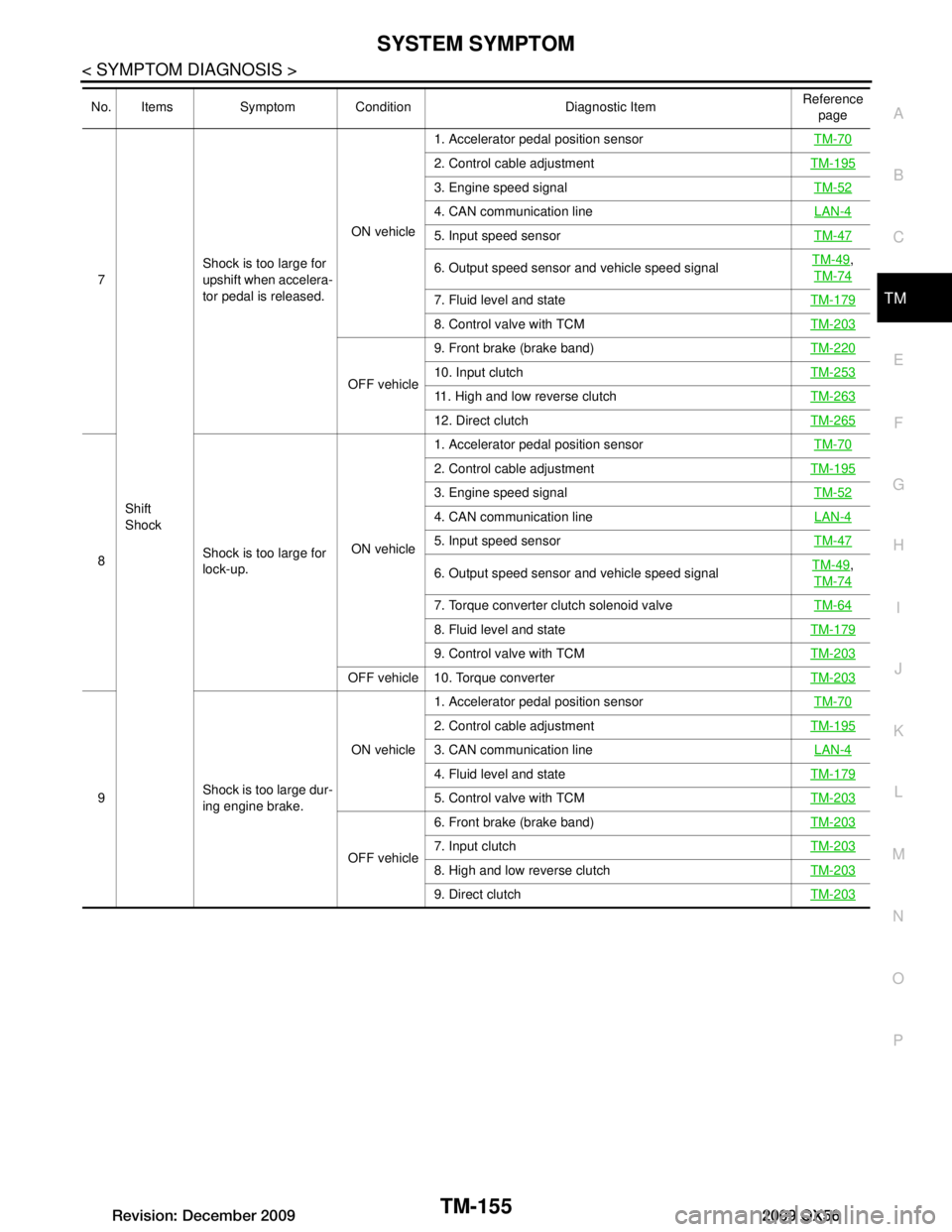
SYSTEM SYMPTOMTM-155
< SYMPTOM DIAGNOSIS >
CEF
G H
I
J
K L
M A
B
TM
N
O P
7
Shift
Shock Shock is too large for
upshift when accelera-
tor pedal is released.
ON vehicle1. Accelerator pedal position sensor
TM-70
2. Control cable adjustmentTM-195
3. Engine speed signal TM-52
4. CAN communication line LAN-4
5. Input speed sensorTM-47
6. Output speed sensor and vehicle speed signalTM-49,
TM-74
7. Fluid level and state TM-179
8. Control valve with TCMTM-203
OFF vehicle9. Front brake (brake band)
TM-22010. Input clutchTM-253
11. High and low reverse clutchTM-263
12. Direct clutchTM-265
8Shock is too large for
lock-up. ON vehicle1. Accelerator pedal position sensor
TM-70
2. Control cable adjustmentTM-195
3. Engine speed signal TM-52
4. CAN communication line LAN-4
5. Input speed sensorTM-47
6. Output speed sensor and vehicle speed signalTM-49,
TM-74
7. Torque converter clutch solenoid valve TM-64
8. Fluid level and stateTM-179
9. Control valve with TCMTM-203
OFF vehicle 10. Torque converter TM-203
9Shock is too large dur-
ing engine brake. ON vehicle
1. Accelerator pedal position sensor
TM-70
2. Control cable adjustmentTM-195
3. CAN communication line LAN-4
4. Fluid level and stateTM-179
5. Control valve with TCMTM-203
OFF vehicle6. Front brake (brake band)
TM-2037. Input clutchTM-203
8. High and low reverse clutchTM-203
9. Direct clutchTM-203
No. Items Symptom Condition Diagnostic Item Reference
page
Revision: December 20092009 QX56
Page 3808 of 4171
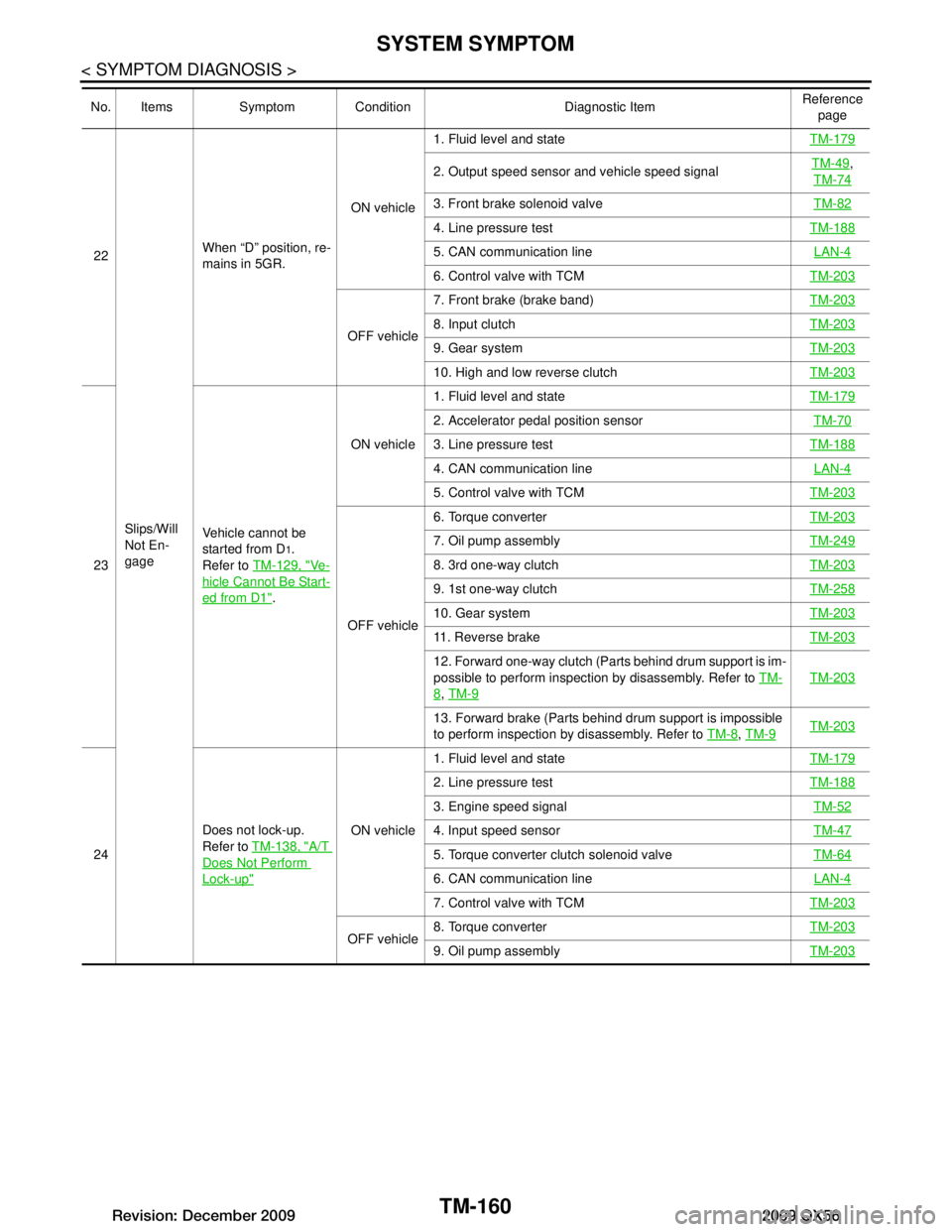
TM-160
< SYMPTOM DIAGNOSIS >
SYSTEM SYMPTOM
22Slips/Will
Not En-
gage When “D” position, re-
mains in 5GR.
ON vehicle1. Fluid level and state
TM-179
2. Output speed sensor and vehicle speed signal TM-49,
TM-74
3. Front brake solenoid valve TM-82
4. Line pressure testTM-188
5. CAN communication line LAN-4
6. Control valve with TCMTM-203
OFF vehicle7. Front brake (brake band)
TM-2038. Input clutchTM-203
9. Gear systemTM-203
10. High and low reverse clutchTM-203
23Vehicle cannot be
started from D
1.
Refer to TM-129, "Ve-
hicle Cannot Be Start-
ed from D1". ON vehicle
1. Fluid level and state
TM-179
2. Accelerator pedal position sensor TM-70
3. Line pressure testTM-188
4. CAN communication line LAN-4
5. Control valve with TCMTM-203
OFF vehicle6. Torque converter
TM-203
7. Oil pump assemblyTM-249
8. 3rd one-way clutchTM-203
9. 1st one-way clutchTM-258
10. Gear systemTM-203
11. Reverse brakeTM-203
12. Forward one-way clutch (Parts behind drum support is im-
possible to perform inspection by disassembly. Refer to TM-
8, TM-9
TM-203
13. Forward brake (Parts behind drum support is impossible
to perform inspection by disassembly. Refer to TM-8
, TM-9TM-203
24 Does not lock-up.
Refer to
TM-138, "A/T Does Not Perform
Lock-up"
ON vehicle 1. Fluid level and state
TM-179
2. Line pressure testTM-188
3. Engine speed signal TM-52
4. Input speed sensorTM-47
5. Torque converter clutch solenoid valveTM-64
6. CAN communication line LAN-4
7. Control valve with TCMTM-203
OFF vehicle8. Torque converter
TM-2039. Oil pump assemblyTM-203
No. Items Symptom Condition Diagnostic Item Reference
page
Revision: December 20092009 QX56
Page 3809 of 4171
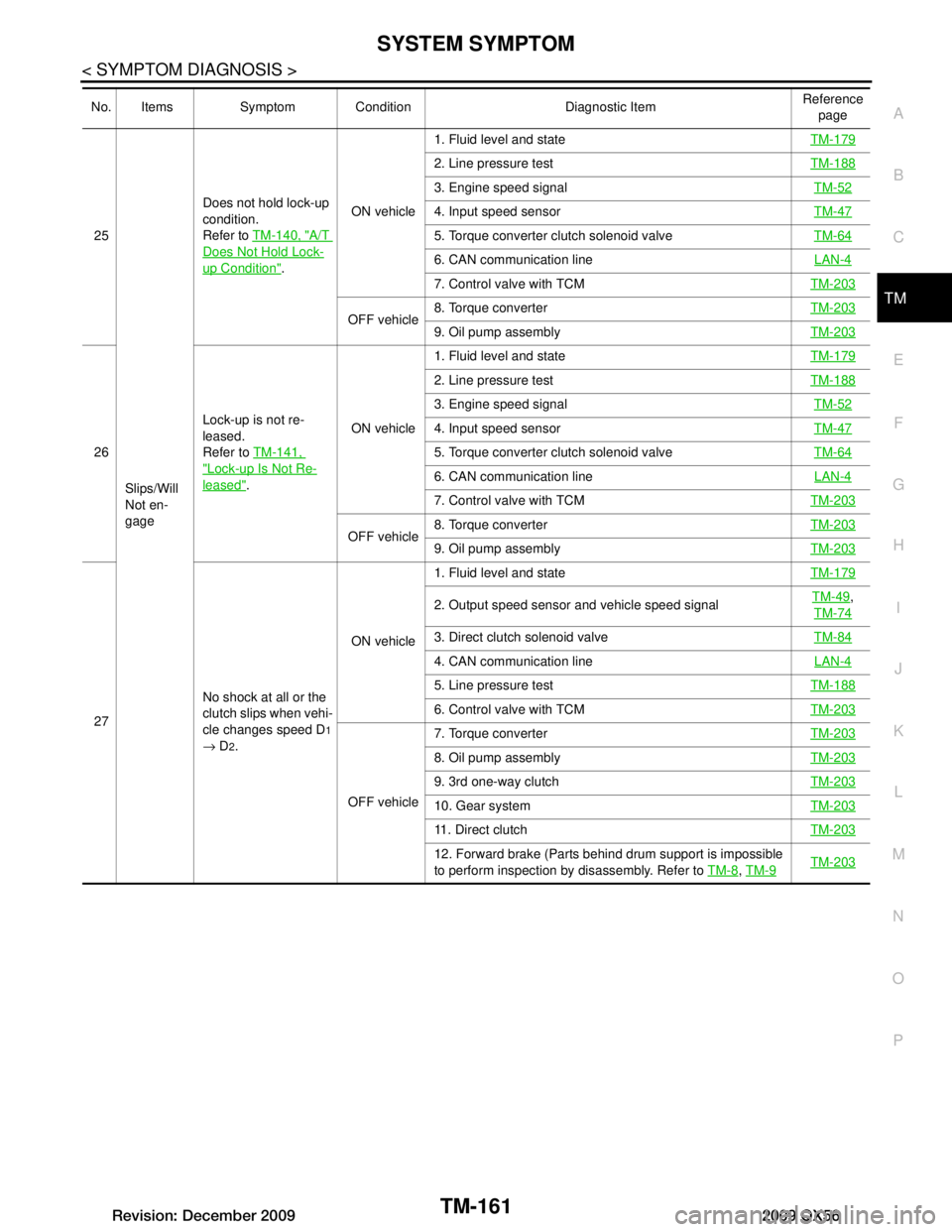
SYSTEM SYMPTOMTM-161
< SYMPTOM DIAGNOSIS >
CEF
G H
I
J
K L
M A
B
TM
N
O P
25
Slips/Will
Not en-
gage Does not hold lock-up
condition.
Refer to
TM-140, "A/T
Does Not Hold Lock-
up Condition". ON vehicle 1. Fluid level and state
TM-179
2. Line pressure testTM-188
3. Engine speed signal TM-52
4. Input speed sensorTM-47
5. Torque converter clutch solenoid valveTM-64
6. CAN communication line LAN-4
7. Control valve with TCMTM-203
OFF vehicle8. Torque converter
TM-2039. Oil pump assemblyTM-203
26Lock-up is not re-
leased.
Refer to
TM-141,
"Lock-up Is Not Re-
leased". ON vehicle1. Fluid level and state
TM-179
2. Line pressure testTM-188
3. Engine speed signal TM-52
4. Input speed sensorTM-47
5. Torque converter clutch solenoid valveTM-64
6. CAN communication line LAN-4
7. Control valve with TCMTM-203
OFF vehicle8. Torque converter
TM-2039. Oil pump assemblyTM-203
27No shock at all or the
clutch slips when vehi-
cle changes speed D1
→
D2. ON vehicle
1. Fluid level and state
TM-179
2. Output speed sensor and vehicle speed signal TM-49,
TM-74
3. Direct clutch solenoid valve TM-84
4. CAN communication line LAN-4
5. Line pressure testTM-188
6. Control valve with TCMTM-203
OFF vehicle7. Torque converter
TM-203
8. Oil pump assemblyTM-203
9. 3rd one-way clutchTM-203
10. Gear systemTM-203
11. Direct clutchTM-203
12. Forward brake (Parts behind drum support is impossible
to perform inspection by disassembly. Refer to TM-8
, TM-9TM-203
No. Items Symptom Condition Diagnostic Item Reference
page
Revision: December 20092009 QX56
Page 3816 of 4171
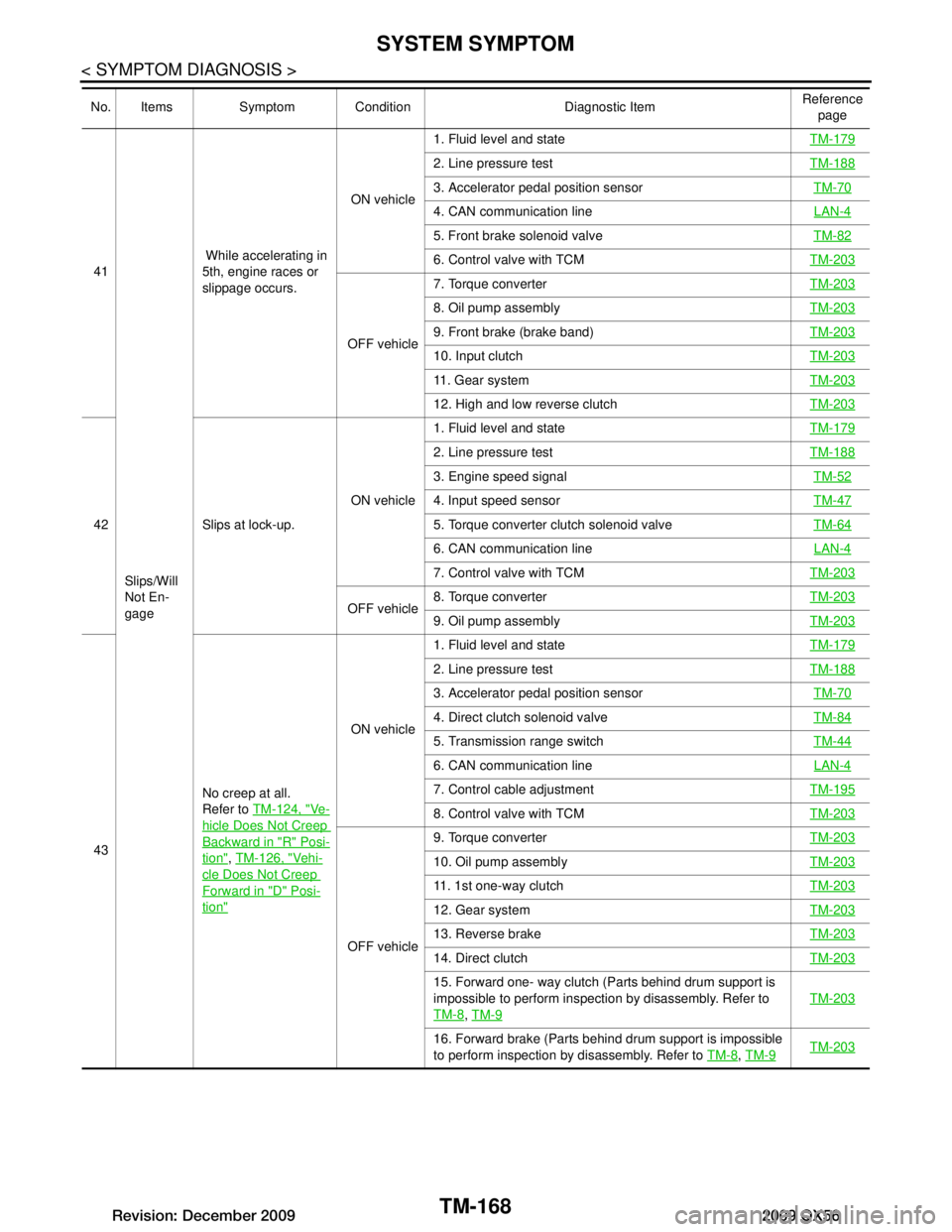
TM-168
< SYMPTOM DIAGNOSIS >
SYSTEM SYMPTOM
41Slips/Will
Not En-
gage While accelerating in
5th, engine races or
slippage occurs.
ON vehicle
1. Fluid level and state
TM-179
2. Line pressure testTM-188
3. Accelerator pedal position sensor TM-70
4. CAN communication line LAN-4
5. Front brake solenoid valveTM-82
6. Control valve with TCMTM-203
OFF vehicle7. Torque converter
TM-203
8. Oil pump assemblyTM-203
9. Front brake (brake band)TM-203
10. Input clutchTM-203
11. Gear systemTM-203
12. High and low reverse clutchTM-203
42 Slips at lock-up.ON vehicle1. Fluid level and state
TM-179
2. Line pressure testTM-188
3. Engine speed signal TM-52
4. Input speed sensorTM-47
5. Torque converter clutch solenoid valveTM-64
6. CAN communication line LAN-4
7. Control valve with TCMTM-203
OFF vehicle8. Torque converter
TM-2039. Oil pump assemblyTM-203
43No creep at all.
Refer to
TM-124, "Ve-
hicle Does Not Creep
Backward in "R" Posi-
tion", TM-126, "Vehi-
cle Does Not Creep
Forward in "D" Posi-
tion"
ON vehicle 1. Fluid level and state
TM-179
2. Line pressure testTM-188
3. Accelerator pedal position sensor TM-70
4. Direct clutch solenoid valveTM-84
5. Transmission range switchTM-44
6. CAN communication line LAN-4
7. Control cable adjustmentTM-195
8. Control valve with TCMTM-203
OFF vehicle9. Torque converter
TM-203
10. Oil pump assemblyTM-203
11. 1st one-way clutchTM-203
12. Gear systemTM-203
13. Reverse brakeTM-203
14. Direct clutchTM-203
15. Forward one- way clutch (Parts behind drum support is
impossible to perform inspection by disassembly. Refer to
TM-8
, TM-9
TM-203
16. Forward brake (Parts behind drum support is impossible
to perform inspection by disassembly. Refer to TM-8
, TM-9TM-203
No. Items Symptom Condition Diagnostic Item Reference
page
Revision: December 20092009 QX56
Page 3818 of 4171
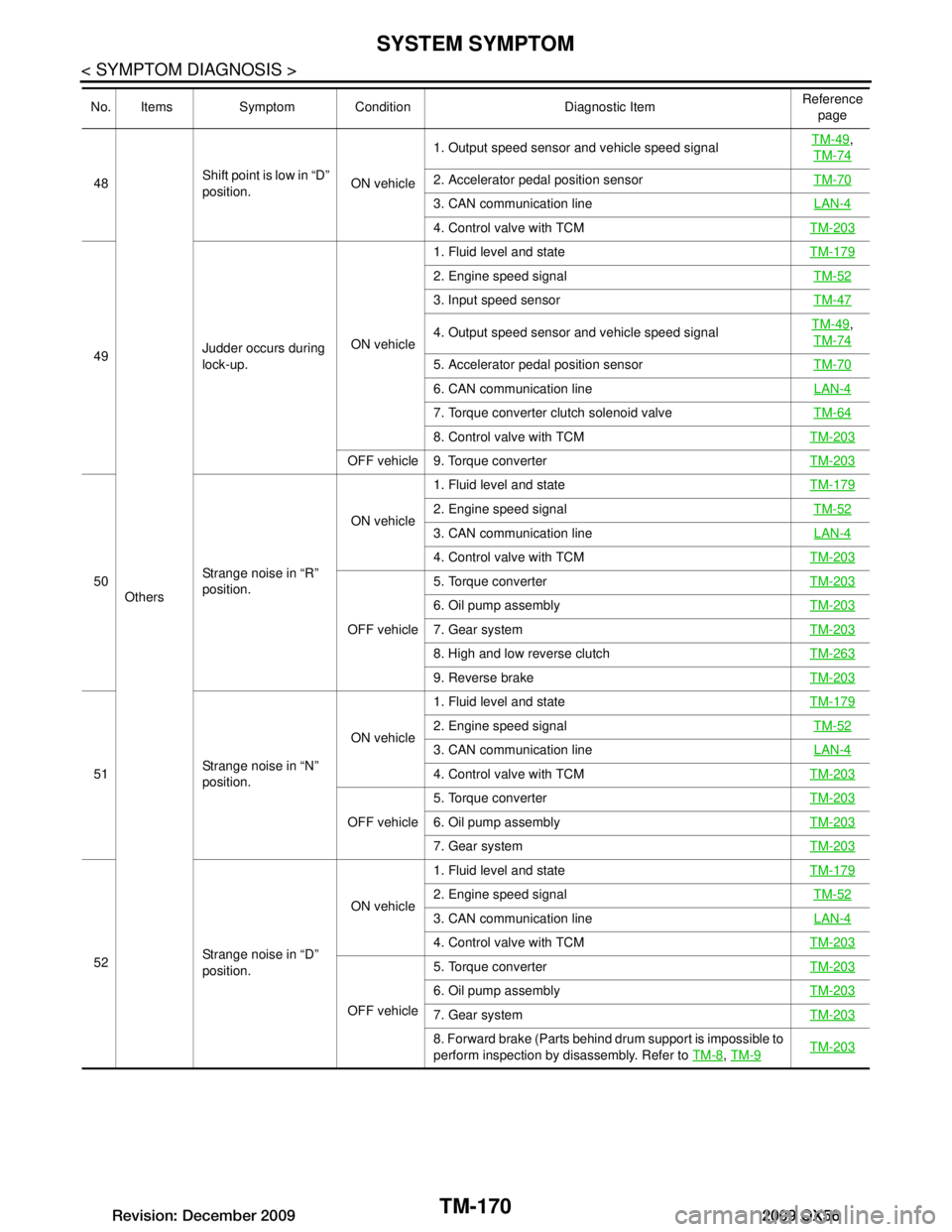
TM-170
< SYMPTOM DIAGNOSIS >
SYSTEM SYMPTOM
48Others Shift point is low in “D”
position.
ON vehicle1. Output speed sensor and vehicle speed signal
TM-49
,
TM-74
2. Accelerator pedal position sensor TM-70
3. CAN communication line LAN-4
4. Control valve with TCMTM-203
49Judder occurs during
lock-up. ON vehicle1. Fluid level and state
TM-179
2. Engine speed signal TM-52
3. Input speed sensorTM-47
4. Output speed sensor and vehicle speed signalTM-49,
TM-74
5. Accelerator pedal position sensor TM-70
6. CAN communication line LAN-4
7. Torque converter clutch solenoid valveTM-64
8. Control valve with TCMTM-203
OFF vehicle 9. Torque converter TM-203
50Strange noise in “R”
position. ON vehicle
1. Fluid level and state
TM-179
2. Engine speed signal TM-52
3. CAN communication line LAN-4
4. Control valve with TCMTM-203
OFF vehicle5. Torque converter
TM-203
6. Oil pump assemblyTM-203
7. Gear systemTM-203
8. High and low reverse clutchTM-263
9. Reverse brakeTM-203
51Strange noise in “N”
position. ON vehicle
1. Fluid level and state
TM-179
2. Engine speed signal TM-52
3. CAN communication line LAN-4
4. Control valve with TCMTM-203
OFF vehicle5. Torque converter
TM-2036. Oil pump assemblyTM-203
7. Gear systemTM-203
52Strange noise in “D”
position. ON vehicle
1. Fluid level and state
TM-179
2. Engine speed signal TM-52
3. CAN communication line LAN-4
4. Control valve with TCMTM-203
OFF vehicle5. Torque converter
TM-203
6. Oil pump assemblyTM-203
7. Gear systemTM-203
8. Forward brake (Parts behind drum support is impossible to
perform inspection by disassembly. Refer to TM-8
, TM-9TM-203
No. Items Symptom Condition Diagnostic Item Reference
page
Revision: December 20092009 QX56
Page 3822 of 4171
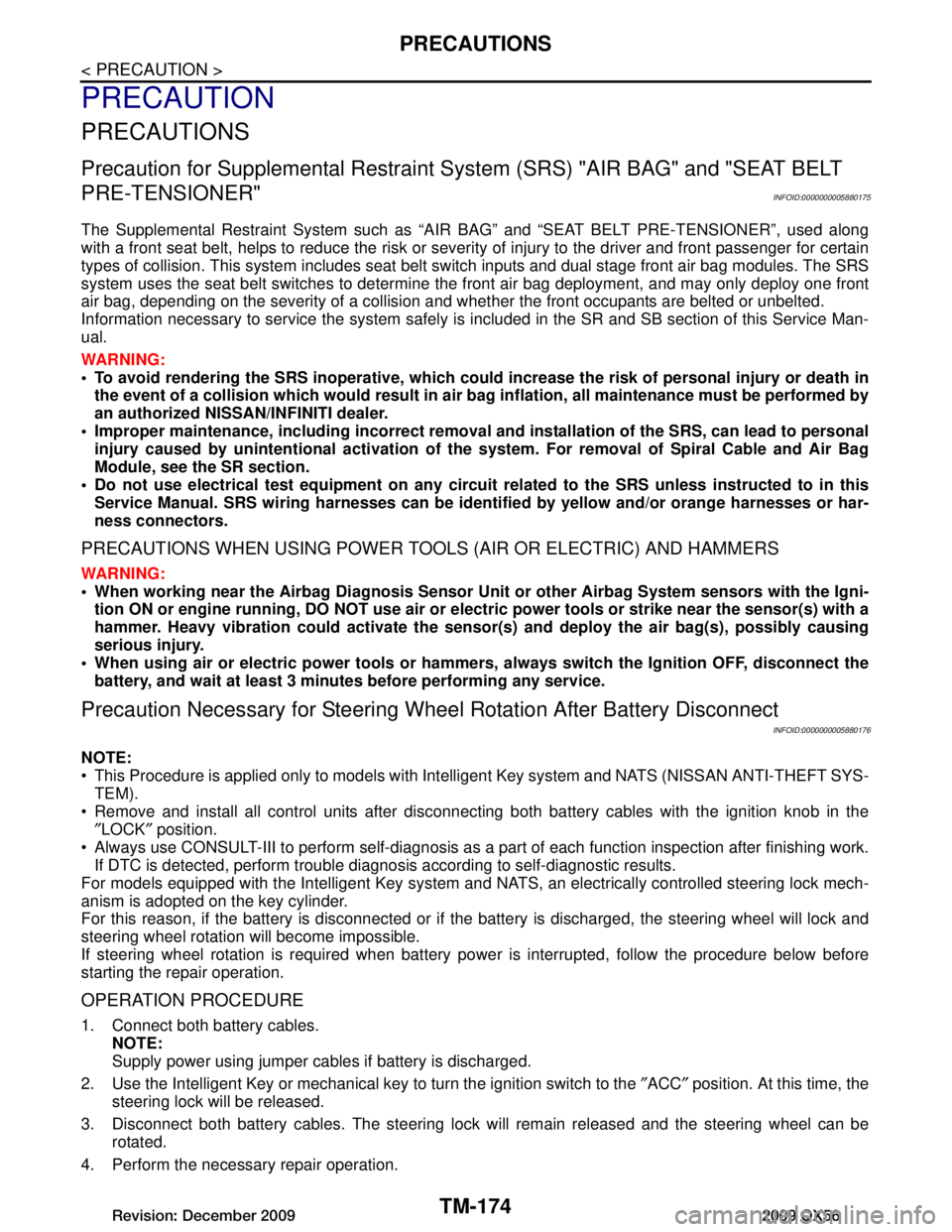
TM-174
< PRECAUTION >
PRECAUTIONS
PRECAUTION
PRECAUTIONS
Precaution for Supplemental Restraint System (SRS) "AIR BAG" and "SEAT BELT
PRE-TENSIONER"
INFOID:0000000005880175
The Supplemental Restraint System such as “A IR BAG” and “SEAT BELT PRE-TENSIONER”, used along
with a front seat belt, helps to reduce the risk or severi ty of injury to the driver and front passenger for certain
types of collision. This system includes seat belt switch inputs and dual stage front air bag modules. The SRS
system uses the seat belt switches to determine the front air bag deployment, and may only deploy one front
air bag, depending on the severity of a collision and w hether the front occupants are belted or unbelted.
Information necessary to service the system safely is included in the SR and SB section of this Service Man-
ual.
WARNING:
To avoid rendering the SRS inopera tive, which could increase the risk of personal injury or death in
the event of a collision which would result in air bag inflation, all maintenance must be performed by
an authorized NISS AN/INFINITI dealer.
Improper maintenance, including in correct removal and installation of the SRS, can lead to personal
injury caused by unintent ional activation of the system. For re moval of Spiral Cable and Air Bag
Module, see the SR section.
Do not use electrical test equipmen t on any circuit related to the SRS unless instructed to in this
Service Manual. SRS wiring harnesses can be identi fied by yellow and/or orange harnesses or har-
ness connectors.
PRECAUTIONS WHEN USING POWER TOOLS (AIR OR ELECTRIC) AND HAMMERS
WARNING:
When working near the Airbag Diagnosis Sensor Unit or other Airbag System sensors with the Igni-
tion ON or engine running, DO NOT use air or electri c power tools or strike near the sensor(s) with a
hammer. Heavy vibration could activate the sensor( s) and deploy the air bag(s), possibly causing
serious injury.
When using air or electric power tools or hammers , always switch the Ignition OFF, disconnect the
battery, and wait at least 3 minu tes before performing any service.
Precaution Necessary for Steering W heel Rotation After Battery Disconnect
INFOID:0000000005880176
NOTE:
This Procedure is applied only to models with Intelli gent Key system and NATS (NISSAN ANTI-THEFT SYS-
TEM).
Remove and install all control units after disconnecting both battery cables with the ignition knob in the
″LOCK ″ position.
Always use CONSULT-III to perform self-diagnosis as a part of each function inspection after finishing work.
If DTC is detected, perform trouble diagnosis according to self-diagnostic results.
For models equipped with the Intelligent Key system and NATS, an electrically controlled steering lock mech-
anism is adopted on the key cylinder.
For this reason, if the battery is disconnected or if the battery is discharged, the steering wheel will lock and
steering wheel rotation will become impossible.
If steering wheel rotation is required when battery pow er is interrupted, follow the procedure below before
starting the repair operation.
OPERATION PROCEDURE
1. Connect both battery cables. NOTE:
Supply power using jumper cables if battery is discharged.
2. Use the Intelligent Key or mechanical key to turn the ignition switch to the ″ACC ″ position. At this time, the
steering lock will be released.
3. Disconnect both battery cables. The steering lock will remain released and the steering wheel can be
rotated.
4. Perform the necessary repair operation.
Revision: December 20092009 QX56